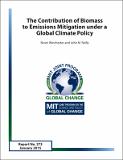| dc.contributor.author | Winchester, N. | |
| dc.contributor.author | Reilly, J.M. | |
| dc.date.accessioned | 2015-03-03T19:19:09Z | |
| dc.date.available | 2015-03-03T19:19:09Z | |
| dc.date.issued | 2015-01 | |
| dc.identifier.uri | http://hdl.handle.net/1721.1/95758 | |
| dc.description.abstract | What will large-scale global bioenergy production look like? We investigate this question by developing a detailed representation of bioenergy in a global economy-wide model. We develop a scenario with a global carbon dioxide price, applied to all anthropogenic emissions except those from land-use change, that rises from $15 per metric ton in 2015 to $59 in 2050. This creates market conditions favorable to biomass energy, resulting in global non traditional bioenergy production of ~150 exajoules (EJ) in 2050. By comparison, in 2010 global energy production was primarily from coal (139 EJ), oil (175 EJ) and gas (108 EJ). With this policy, 2050 emissions are 16% less in our Base Policy case than our Reference case, although extending the scope of the carbon price to include emissions from land-use change would reduce 2050 emissions by 57% relative to the same baseline. Our results from various policy scenarios show that lignocellulosic (LC) ethanol may become the major form of bioenergy, if its production costs fall by amounts predicted in a recent survey and ethanol blending constraints disappear by 2030; however, if its costs remain higher than expected or the ethanol blend wall continues to bind, bioelectricity and bioheat may prevail. Higher LC ethanol costs may also result in expanded production of first-generation biofuels (ethanol from sugarcane and corn) so that they remain in the fuel mix through 2050. Deforestation occurs if emissions from land-use change are not priced, although the availability of biomass residues and improvements in crop yields and conversion efficiencies mitigate pressure on land markets. As regions are linked via international agricultural markets, irrespective of the location of bioenergy production, natural forest decreases are largest in regions with the lowest political constraints to deforestation. The combination of carbon price and bioenergy production increases food prices by 2.6%–4.7%, with bioenergy accounting for 1.3%–2.6%. | en_US |
| dc.description.sponsorship | Primary funding for this research was through a sponsored research agreement with BP. The authors also acknowledge support in the basic development of the Economic Projection and Policy Analysis model from the Joint Program on the Science and Policy of Global Change, which is funded by a consortium of industrial sponsors and Federal grants including core funding in support of basic research under U.S. Environmental Protection Agency (EPA-XA-83600001) and U.S. Department of Energy, Office of Science (DE-FG02-94ER61937). For a complete list of sponsors see for complete list see http://globalchange.mit.edu/sponsors/current.html). | en_US |
| dc.language.iso | en_US | en_US |
| dc.publisher | MIT Joint Program on the Science and Policy of Global Change | en_US |
| dc.relation.ispartofseries | MIT Joint Program Report Series;273 | |
| dc.title | The Contribution of Biomass to Emissions Mitigation under a Global Climate Policy | en_US |
| dc.type | Technical Report | en_US |
| dc.identifier.citation | Report 273 | en_US |
